
“This is a story of two families of children, with a couple of sailing boats, on a lake.” These words are written on the front flap of the first edition of Swallows and Amazons, and scarcely seem the stuff to enthrall readers over the decades. However Ransome’s delightful evocation of a wonderful summer of adventure, discovery and friendship is as fresh and compelling today as it ever was.
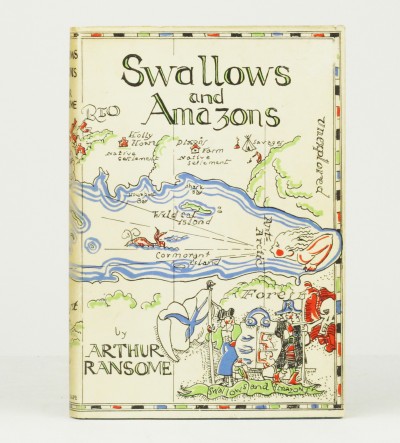
It all began in 1928 when Ransome and his wife Evgenia met up with their friends, the Altounyan family, who were staying with their Collingwood grandparents at Coniston in the Lake District. The two families bought a couple of dinghies, named Swallow and Mavis (later renamed Amazon), and Ransome elected to teach the five children to sail. After the Altounyan’s departure at the end of the summer holidays, Ransome decided to write an adventure story loosely based on the exploits of the children and their time on the lake. In the spring of 1929 therefore he presented a synopsis and 50 pages of Swallows and Amazons to his publishers, Jonathan Cape, who were enthusiastic about him continuing. Upon receiving the completed typescript in April 1930, Cape turned to Steven Spurrier to illustrate the book and he produced at least 23 drawings in addition to a title-page vignette and two maps, but Ransome disliked the drawings so much that only the dustwrapper, endpaper and frontispiece designs were retained for publication.
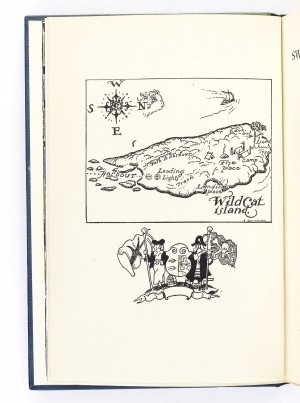
Frontis by Steven Spurrier, 1930
Despite his reservations about the illustrations, Ransome was hugely excited about the prospect of the impending publication. In early July 1930, he wrote “I have had a letter from Cape’s, to say that all goes well with binding etc., and that they now feel they can count on publishing Swallows and Amazons on July 21. I feel quite childish about it, bursting to see the brute and feel it.”
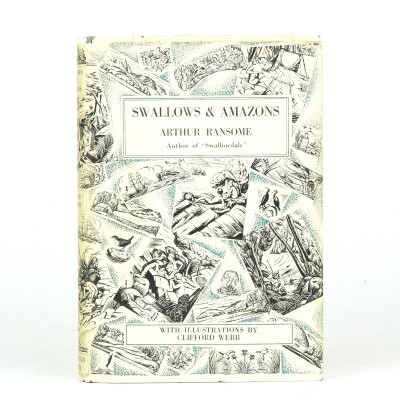
First edition illustrated by Clifford Webb, 1931
Little more than a year later Cape issued an illustrated edition, published on 28 September 1931, and although they retained Spurrier’s map designs, they included 28 black and white illustrations by Clifford Webb, who also designed the dustwrapper. Ransome was keen to have the book illustrated but was concerned that the artwork would be both inaccurate as regards the depictions of the boats and too specific as regards the characterization of the children, so although Ransome agreed to the use of Webb’s illustrations he was not overwhelmingly enthusiastic about them, much preferring those pictures in which the faces of the characters were obscured or undeliniated.
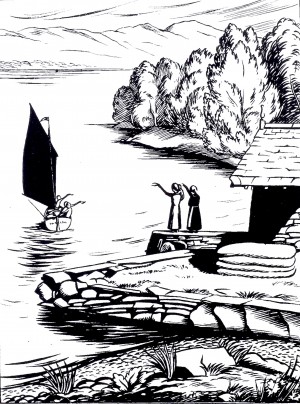
Frontis by Clifford Webb, 1931
Webb went on to illustrate the next book in the series, Swallowdale (1931) but with Peter Duck (1932) Ransome decided that he would take over the illustration work himself, and the remaining books in the series were all illustrated by him.

First edition illustrated by Arthur Ransome, 1938
He was not a talented artist but stated that “the pictures were supposed to have been made by the children themselves to illustrate the story they had themselves invented, so the bad drawing did not matter very much”. He had always wanted to illustrate Swallows and Amazons, but it was not until the fourteenth edition of the book, published in November 1938 that he felt he was able to do so. Again Cape retained Spurrier’s vignette and map of Wild Cat Island , and two of Webb’s vignettes but the remaining illustrations, including the montage of illustrations on the dustwrapper, were all Ransome’s own.
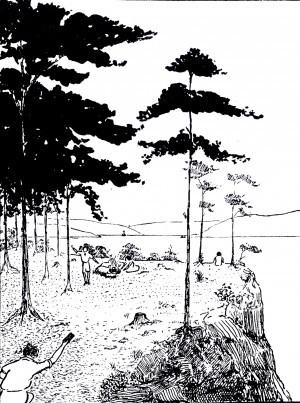
Frontis by Arthur Ransome, 1938
The book was critically well received, The Sunday Times giving a very positive review, saying it was written by “a master story teller, sympathetically in touch with real children and their interests, has created characters who are accepted as friends by children everywhere, not to mention plots which are eminently plausible and unexpected”. However the book did not sell particularly well, in the first 8 months only 1600 copies of the 2000 copies printed were sold (although one of these was bought by the Queen, which heartened Ransome enormously). Despite its rather lackluster commercial performance, its favourable critical reception encouraged Ransome to write the further adventures of John, Susan, Titty and Roger Walker (The Swallows) and Nancy and Peggy Blackett (The Amazons) and with Peter Duck, the third in the series, he finally achieved the commercial success he had been looking for. Over the following 17 years he wrote 12 novels in the series, in the process creating a “first class yarn for boys and girls” which evokes wishfully nostalgic memories of a carefree childhood set in long, hot summer days devising camps and having sailing adventures. On the front flap of the first edition is written “This is … a spontaneous and thoroughly successful effort to write a book about children for children and for their parents, guardians, cousins and aunts.” Ransome’s ability to write books that could be read by both children and adults has ensured the longevity of the series, and its placement firmly in the ranks of classic children’s literature.
“Swallows and Amazons for ever!”
Swallows and Amazons Series
We Didn't Mean to Go to Sea, 1937
The Picts and The Martyrs: or Not Welcome At All, 1943
Comments
Recent Posts
- The Evolution of Crime
- Tour The Bookshop On Your Screen
- The Genesis of Mr. Toad: A Short Publication History of The Wind In The Willows
- Frank Hurley's 'South'
- The "Other" Florence Harrison
- Picturing Enid Blyton
- Advent Calendar of Illustration 2020
- Depicting Jeeves and Wooster
- Evelyn Waugh Reviews Nancy Mitford
- The Envelope Booklets of T.N. Foulis
- "To Die Like English Gentlemen"
- Kay Nielsen's Fantasy World
- A Brief Look at Woodcut Illustration
- The Wealth Of Nations by Adam Smith
- What Big Stories You Have: Brothers Grimm
- Shackleton's Antarctic Career
- Inspiring Errol Le Cain's Fantasy Artwork
- Charlie & The Great Glass Elevator
- Firsts London - An Audio Tour Of Our Booth
- Jessie M. King's Poetic Art, Books & Jewellery
Blog Archive
- January 2024 (1)
- January 2023 (1)
- August 2022 (1)
- January 2022 (1)
- February 2021 (1)
- January 2021 (1)
- December 2020 (1)
- August 2020 (1)
- July 2020 (2)
- March 2020 (3)
- February 2020 (2)
- October 2019 (2)
- July 2019 (2)
- May 2019 (1)
- April 2019 (1)
- March 2019 (2)
- February 2019 (1)
- December 2018 (1)
- November 2018 (1)
- October 2018 (2)
tom 10/Sep/2018 02:19
this is wonderful. I like this post. Best wish for you
loving you forever quotes
e
Anna Marsden 30/Jul/2018 22:46
I was searching for the chronology of the books in the series having just finished S and A and it was hard work to find them. I found your article which ticked that box beautifully and gave me other insights, thank you By sheer coincidence I have just been reading a back issue of my local paper on return from.holiday are you the same gentleman who has just published a book of poetry for children? -congratulations!